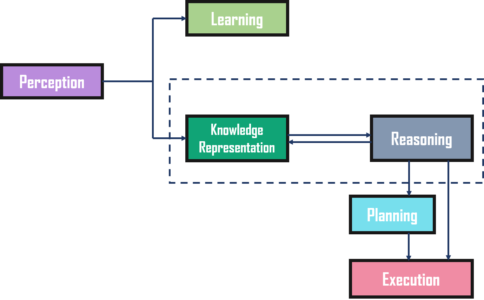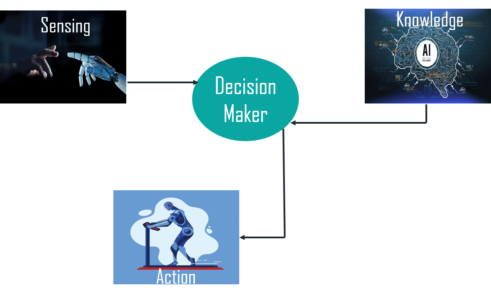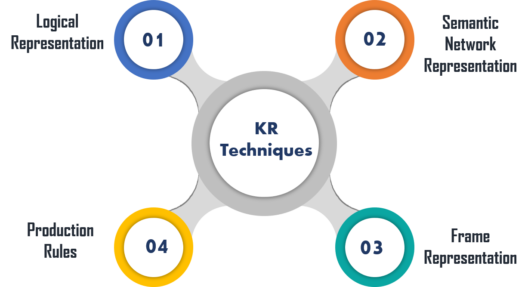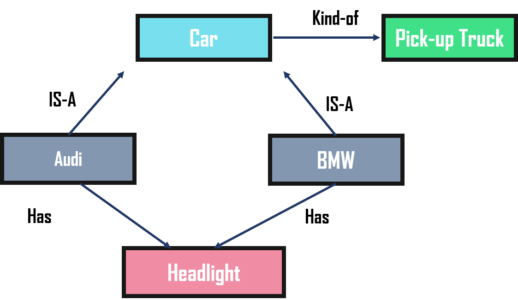Artificial Intelligence Certification Course
- 19k Enrolled Learners
- Weekend
- Live Class
Human beings are good at understanding, reasoning and interpreting knowledge. Using this knowledge, they are able to perform various actions in the real world. But how do machines perform the same? In this article, we will learn about Knowledge Representation in AI and how it helps the machines perform reasoning and interpretation using Artificial Intelligence in the following sequence:
Knowledge Representation in AI describes the representation of knowledge. Basically, it is a study of how the beliefs, intentions, and judgments of an intelligent agent can be expressed suitably for automated reasoning. One of the primary purposes of Knowledge Representation includes modeling intelligent behavior for an agent.
Knowledge Representation and Reasoning (KR, KRR) represents information from the real world for a computer to understand and then utilize this knowledge to solve complex real-life problems like communicating with human beings in natural language. Knowledge representation in AI is not just about storing data in a database, it allows a machine to learn from that knowledge and behave intelligently like a human being.
The different kinds of knowledge that need to be represented in AI include:
Now that you know about Knowledge representation in AI, let’s move on and know about the different types of Knowledge.
There are 5 types of Knowledge such as:
Declarative Knowledge – It includes concepts, facts, and objects and expressed in a declarative sentence.
Structural Knowledge – It is a basic problem-solving knowledge that describes the relationship between concepts and objects.
Procedural Knowledge – This is responsible for knowing how to do something and includes rules, strategies, procedures, etc.
Meta Knowledge – Meta Knowledge defines knowledge about other types of Knowledge.
Heuristic Knowledge – This represents some expert knowledge in the field or subject.
These are the important types of Knowledge Representation in AI. Now, let’s have a look at the cycle of knowledge representation and how it works.
Artificial Intelligent Systems usually consist of various components to display their intelligent behavior. Some of these components include:
Here is an example to show the different components of the system and how it works:

The above diagram shows the interaction of an AI system with the real world and the components involved in showing intelligence.
So, these are the different components of the cycle of Knowledge Representation in AI. Now, let’s understand the relationship between knowledge and intelligence.
In the real world, knowledge plays a vital role in intelligence as well as creating artificial intelligence. It demonstrates the intelligent behavior in AI agents or systems. It is possible for an agent or system to act accurately on some input only when it has the knowledge or experience about the input.
Let’s take an example to understand the relationship:

In this example, there is one decision-maker whose actions are justified by sensing the environment and using knowledge. But, if we remove the knowledge part here, it will not be able to display any intelligent behavior.
Now that you know the relationship between knowledge and intelligence, let’s move on to the techniques of Knowledge Representation in AI.
There are four techniques of representing knowledge such as:

Now, let’s discuss these techniques in detail.
Logical representation is a language with some definite rules which deal with propositions and has no ambiguity in representation. It represents a conclusion based on various conditions and lays down some important communication rules. Also, it consists of precisely defined syntax and semantics which supports the sound inference. Each sentence can be translated into logics using syntax and semantics.
| Syntax | Semantics |
|
|
Advantages:
Disadvantages:
Semantic networks work as an alternative of predicate logic for knowledge representation. In Semantic networks, you can represent your knowledge in the form of graphical networks. This network consists of nodes representing objects and arcs which describe the relationship between those objects. Also, it categorizes the object in different forms and links those objects.
This representation consist of two types of relations:

Advantages:
Disadvantages:
Frame Representation
A frame is a record like structure that consists of a collection of attributes and values to describe an entity in the world. These are the AI data structure that divides knowledge into substructures by representing stereotypes situations. Basically, it consists of a collection of slots and slot values of any type and size. Slots have names and values which are called facets.
Advantages:
Disadvantages:
In production rules, agent checks for the condition and if the condition exists then production rule fires and corresponding action is carried out. The condition part of the rule determines which rule may be applied to a problem. Whereas, the action part carries out the associated problem-solving steps. This complete process is called a recognize-act cycle.
The production rules system consists of three main parts:
Advantages:
The production rules are expressed in natural language.
The production rules are highly modular and can be easily removed or modified.
Disadvantages:
It does not exhibit any learning capabilities and does not store the result of the problem for future uses.
During the execution of the program, many rules may be active. Thus, rule-based production systems are inefficient.
So, these were the important techniques for Knowledge Representation in AI. Now, let’s have a look at the requirements for these representations.
A good knowledge representation system must have properties such as:
Representational Accuracy: It should represent all kinds of required knowledge.
Inferential Adequacy: It should be able to manipulate the representational structures to produce new knowledge corresponding to the existing structure.
Inferential Efficiency: The ability to direct the inferential knowledge mechanism into the most productive directions by storing appropriate guides.
Acquisitional efficiency: The ability to acquire new knowledge easily using automatic methods.
Now, let’s have a look at some of the approaches to Knowledge Representation in AI along with different examples.
There are different approaches to knowledge representation such as:
It is the simplest way of storing facts which uses the relational method. Here, all the facts about a set of the object are set out systematically in columns. Also, this approach of knowledge representation is famous in database systems where the relationship between different entities is represented. Thus, there is little opportunity for inference.
Example:
| Name | Age | Emp ID |
| John | 25 | 100071 |
| Amanda | 23 | 100056 |
| Sam | 27 | 100042 |
This is an example of representing simple relational knowledge.
In the inheritable knowledge approach, all data must be stored into a hierarchy of classes and should be arranged in a generalized form or a hierarchal manner. Also, this approach contains inheritable knowledge which shows a relation between instance and class, and it is called instance relation. In this approach, objects and values are represented in Boxed nodes.
Example:

The inferential knowledge approach represents knowledge in the form of formal logic. Thus, it can be used to derive more facts. Also, it guarantees correctness.
Example:
Statement 1: John is a cricketer.
Statement 2: All cricketers are athletes.
Then it can be represented as;
Cricketer(John)
∀x = Cricketer (x) ———-> Athelete (x)s
These were some of the approaches to knowledge representation in AI along with examples. With this, we have come to the end of our article. I hope you understood what is Knowledge Representation in AI and its different types.
Learn more about this trending OpenAI chatbot concept and implementation join the ChatGPT training.
Also, check out the AI Course is curated by industry professionals as per the industry requirements & demands. Thus, You will master the concepts such as SoftMax function, Autoencoder Neural Networks, Restricted Boltzmann Machine (RBM) and work with libraries like Keras & TFLearn. The course has been specially curated by industry experts with real-time case studies.
Got a question for us? Please mention it in the comments section of “Knowledge Representation in AI” and we will get back to you.
 Thank you for registering Join Edureka Meetup community for 100+ Free Webinars each month JOIN MEETUP GROUP
Thank you for registering Join Edureka Meetup community for 100+ Free Webinars each month JOIN MEETUP GROUPedureka.co